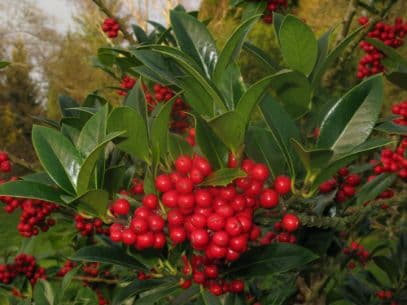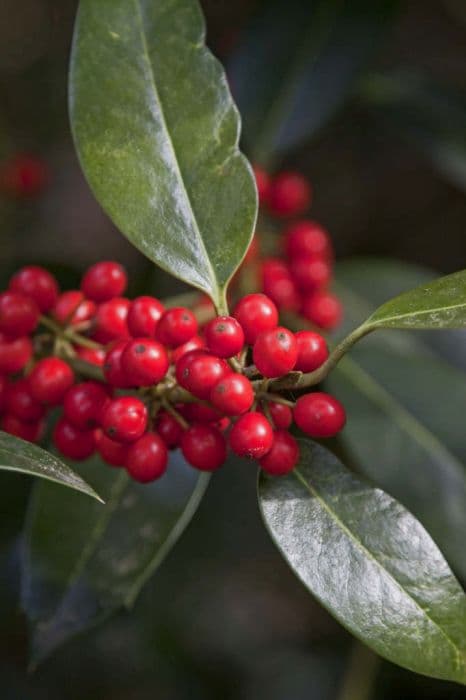Japanese Holly Ilex crenata (Fastigata Group) 'Fastigiata' (f)

ABOUT
Ilex crenata, commonly known as Japanese holly, is an evergreen shrub known for its compact and dense growth habit, resembling English boxwood. 'Fastigiata' is a particular form with a notably upright and columnar shape. The leaves of this plant are small, glossy, and dark green with a slightly scalloped edge, giving it a refined texture. Despite being a holly, its leaves lack the spiky points commonly associated with the genus, making it a popular choice for gardens seeking the aesthetic of holly without the sharp foliage. The Japanese holly 'Fastigiata' produces tiny white flowers in the spring, which are usually inconspicuous among the dense foliage. Following the flowering period, it may bear small black berries that can attract birds and wildlife to the garden. This plant is favored for its elegant form and the ease with which it can be pruned and shaped, making it a versatile choice for formal hedge or topiary work. Its appearance exudes a classic charm that complements a variety of landscapes.
About this plant
 Names
NamesFamily
Aquifoliaceae.
Synonyms
Japanese Holly, Box-leaved Holly, Sky Pencil Holly.
Common names
Ilex crenata 'Fastigiata'.
 Toxicity
ToxicityTo humans
Japanese holly is considered to have a low level of toxicity to humans. However, if parts of the plant, particularly the berries, are ingested, they can cause nausea, vomiting, diarrhea, and stomach cramps. It is advisable to seek medical attention if ingestion occurs, especially for children, who are more sensitive to the toxic substances in the plant.
To pets
Japanese holly is also toxic to pets, such as cats and dogs. If a pet ingests leaves or berries of this plant, they may exhibit symptoms like vomiting, diarrhea, and depression. The berries contain saponins, which can be more problematic when consumed in larger quantities. Pet owners should be cautious to prevent pets from accessing the plant, and contact a veterinarian if they suspect their pet has ingested any part of it.
 Characteristics
CharacteristicsLife cycle
Perennials
Foliage type
Evergreen
Color of leaves
Green
Flower color
White
Height
6-10 feet (1.8-3 meters)
Spread
2-3 feet (0.6-0.9 meters)
Plant type
Shrub
Hardiness zones
5
Native area
Japan
Benefits
 General Benefits
General Benefits- Aesthetic Appeal: Adds visual interest to gardens due to its upright, columnar growth habit and dark green, glossy leaves.
- Low Maintenance: Requires minimal care once established and is quite resilient, making it suitable for urban or low-maintenance landscapes.
- Versatility: Can be used in a variety of landscape applications, including as a hedging plant, topiary, or a standalone specimen.
- Evergreen Foliage: Provides year-round interest since it retains its leaves throughout all the seasons.
- Wildlife Habitat: Offers shelter and potential food sources for birds and other wildlife within the landscape.
- Compact Size: Ideal for small gardens or spaces where a full-size holly would be too large.
- Soil Adaptability: Can thrive in a range of soil types, though it prefers well-drained, acidic soils.
- Disease Resistance: Shows resistance to many of the common holly diseases, reducing the need for chemical treatments.
- Hardiness: This plant is adaptable to a range of temperatures and can withstand cold weather, making it suitable for various climates.
 Medical Properties
Medical PropertiesThis plant is not used for medical purposes.
 Air-purifying Qualities
Air-purifying QualitiesThis plant is not specifically known for air purifying qualities.
 Other Uses
Other Uses- Privacy Screening: Japanese Holly 'Fastigiata' can be used to create a dense, evergreen privacy screen due to its upright, columnar growth habit.
- Topiary: The dense foliage and small leaves of Japanese Holly 'Fastigiata' are ideal for shaping into topiary forms, often used in formal gardens.
- Urban Plantings: Due to its tolerance of pollution and its ability to thrive in confined spaces, Japanese Holly 'Fastigiata' is suitable for urban landscapes and roadside plantings.
- Sound Barrier: The thick foliage can help to absorb noise, making it an effective sound barrier when planted in a row along busy areas.
- Bonsai: Japanese Holly 'Fastigiata' can be cultivated as a bonsai, thanks to its miniature leaves and woody stems which can be artistically shaped.
- Windbreaks: Its dense growing habit makes it an excellent choice for windbreaks around properties or to protect more sensitive plants from strong winds.
- Container Gardening: Smaller specimens can be grown in containers to adorn patios, balconies, or as accent pieces at entrances.
- Wildlife Habitat: The dense branches can provide nesting sites for birds and a safe haven for small wildlife.
- Seasonal Interest: While not known for flashy flowers, the small black berries and occasional small white flowers can add subtle interest to the garden.
- Creative Fencing: The plant can be trained to grow in specific patterns or frameworks, creating unique and creative living fence designs.
Interesting Facts
 Feng Shui
Feng ShuiThe Japanese Holly is not used in Feng Shui practice.
 Zodiac Sign Compitability
Zodiac Sign CompitabilityThe Japanese Holly is not used in astrology practice.
 Plant Symbolism
Plant Symbolism- Protection: Ilex crenata, commonly known as Japanese holly, has pointed leaves that historically symbolize protection and the warding off of negative energy.
- Everlasting Life: Being an evergreen plant, Japanese holly represents immortality and eternal life, as it maintains its green foliage throughout the year.
- Good Fortune: In some cultures, the holly is associated with good luck and is thought to bring prosperity and good fortune to the household.
- Hope: The resilience and long-lasting nature of Japanese holly signify hope and the ability to overcome challenges.
 Water
WaterThe Japanese Holly 'Fastigiata' should be watered deeply and infrequently to mimic natural rainfall, ensuring the soil is moist but not waterlogged. Typically, you should provide about 1 to 1.5 gallons of water per week during the growing season. In the absence of rain, watering may need to increase to twice a week, but always check the soil about 2 to 3 inches deep; if it's dry, it's time to water again. During winter, reduce watering since the plant's growth slows down and it requires less moisture. Overhead watering is recommended in the morning to allow foliage to dry throughout the day, which helps prevent disease.
 Light
LightJapanese Holly 'Fastigiata' thrives in a location with full sun to partial shade. The ideal spot would receive at least 4 to 6 hours of direct sunlight daily, but it can also tolerate light shade, especially in hotter climates. Avoid deep shade, as it can lead to poor growth and sparse foliage.
 Temperature
TemperatureJapanese Holly 'Fastigiata' is hardy and can tolerate a wide range of temperatures. It can survive minimum winter temperatures down to about 0°F but prefers a climate where temperatures stay above this threshold. The plant's ideal growing temperatures are between 50°F and 75°F. During extreme heat, it is vital to keep the plant well-watered to avoid stress.
 Pruning
PruningPrune Japanese Holly 'Fastigiata' to maintain its shape and encourage denser foliage. The best time for pruning is in late winter or early spring before new growth begins. Pruning may be done again in mid-summer, if necessary, to control size or remove any damaged or diseased branches. However, avoid heavy pruning late in the season, as this can leave new growth vulnerable to winter damage.
 Cleaning
CleaningAs needed
 Soil
SoilJapanese Holly 'Fastigiata' thrives in moist, well-drained soil with a slightly acidic to neutral pH of 5.5 to 7.0. The best soil mix is a combination of loamy garden soil, peat moss, and perlite or sand to ensure good drainage and aeration.
 Repotting
RepottingJapanese Holly 'Fastigiata' doesn't require frequent repotting; it can be done every 2 to 3 years as the plant grows or when the roots become pot-bound.
 Humidity & Misting
Humidity & MistingJapanese Holly 'Fastigiata' is tolerant of a wide range of humidity levels, but it does best with moderate humidity in its environment.
 Suitable locations
Suitable locationsIndoor
Place near a sunny window; water when the topsoil is dry.
Outdoor
Plant in well-drained soil; partial to full sun exposure.
Hardiness zone
5-8 USDA
 Life cycle
Life cycleIlex crenata 'Fastigiata', commonly known as Japanese Holly, commences its life cycle with seed germination, which occurs in moist, well-drained soil conditions with partial to full sunlight exposure. Once the seedling emerges, it enters a juvenile vegetative stage, growing slowly into a bushy, upright, and columnar evergreen shrub. During this period, the plant develops its characteristic small, glossy, dark green leaves and begins to establish a strong root system. After several years, the Japanese Holly matures and reaches its reproductive stage, where it produces tiny white flowers in late spring to early summer, which are followed by black berries if a male pollinator is present, as 'Fastigiata' is a female form. The plant continues to grow in height and width, but growth rate slows down with maturity. Throughout its lifespan, which can be several decades, Japanese Holly requires periodic pruning to maintain its desired shape and may undergo cycles of growth and dormancy annually, influenced by seasonal changes.
 Propogation
PropogationPropogation time
Spring-Early Summer
The Japanese Holly 'Fastigiata' is often propagated by semi-hardwood cuttings. This involves taking cuttings from the plant during the late summer. Shoots that are partially matured from the current season's growth, usually around 4 to 6 inches (10 to 15 centimeters) in length, are selected. The lower leaves are removed, and the cut end is often treated with a rooting hormone to encourage root development. Then, the cuttings are placed in a well-draining rooting medium, such as a mixture of peat and perlite. It's important to maintain high humidity around the cuttings by covering them with a plastic dome or using a misting system, and keeping them in indirect light until roots have sufficiently formed to allow for transplanting.









